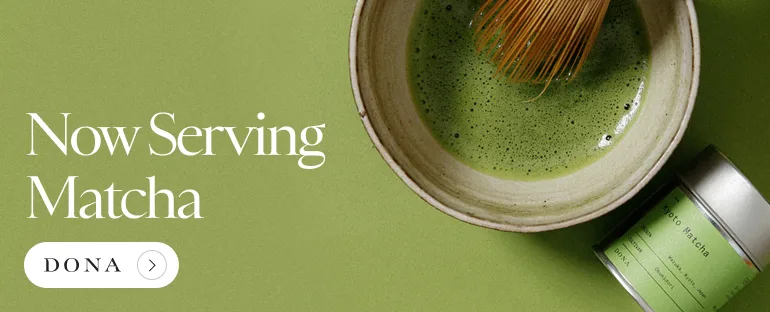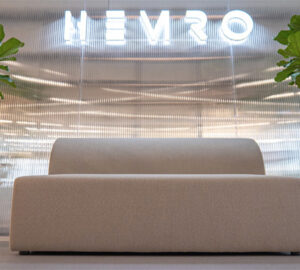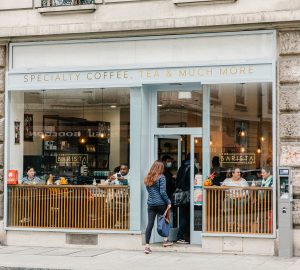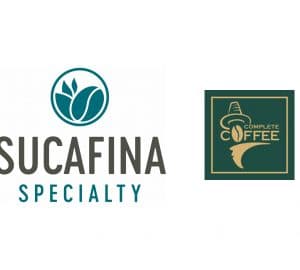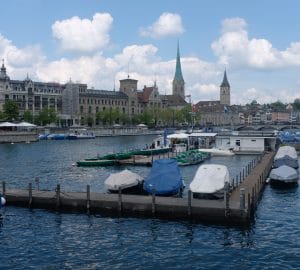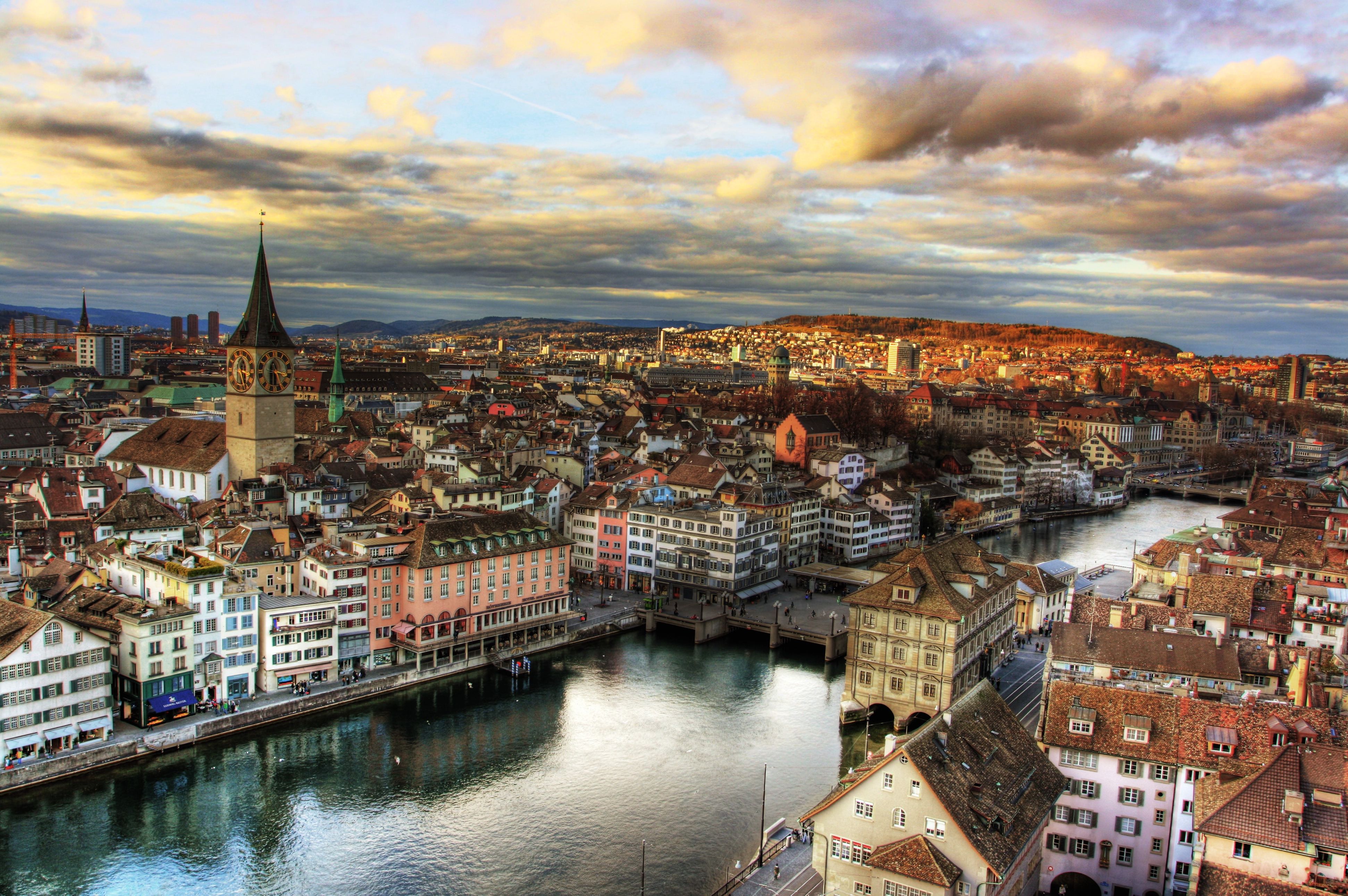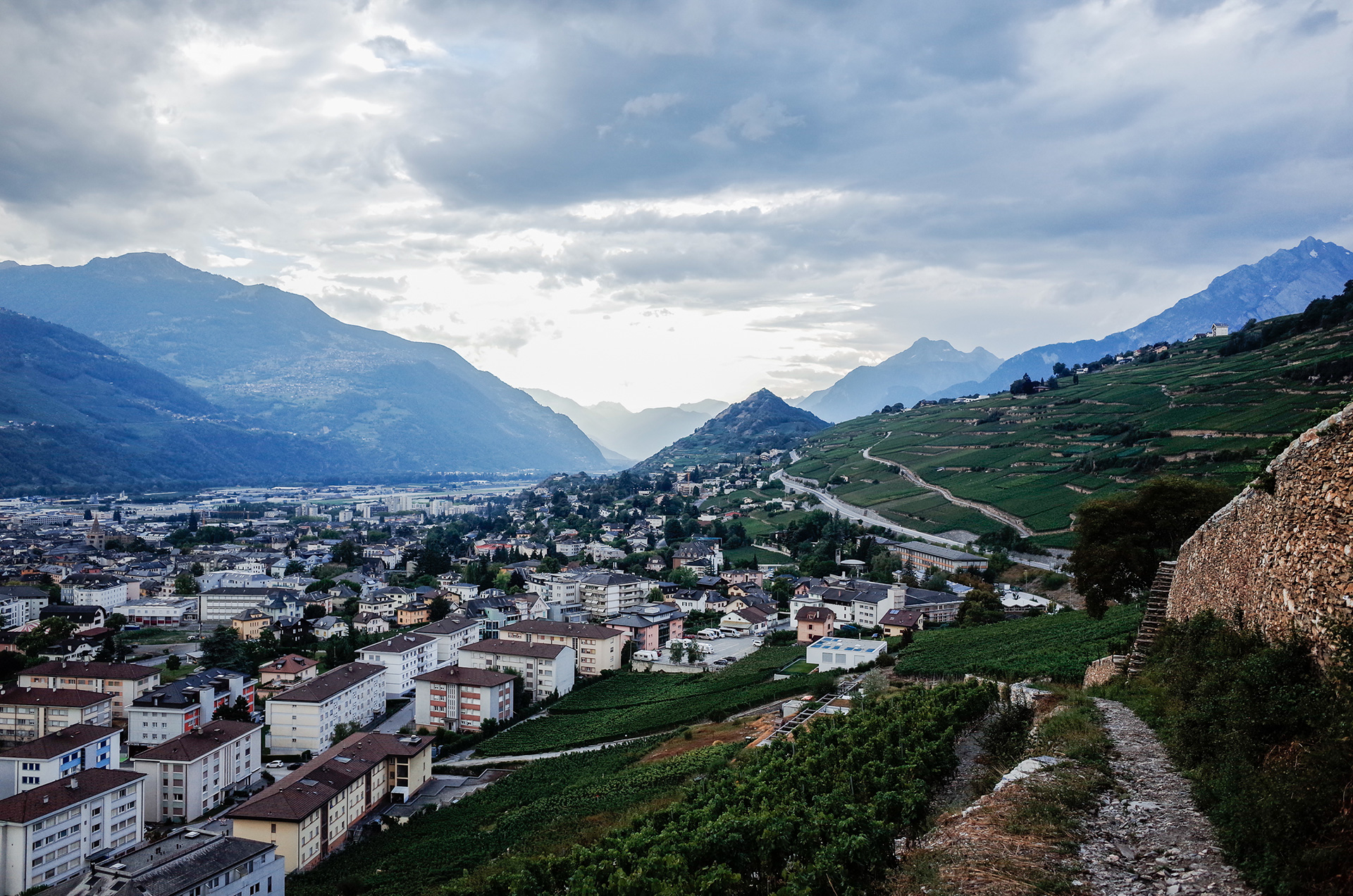
Hans-Peter Schmidt gazed across the Rhône valley in the Canton of Valais, garnished with vines as far as the eye could see, from the forest break at the highest perch of his carbon positive vineyard and experimental farm: Mythopia. With one hand filled with blackcurrants just picked moments before, he waved the palm of his free hand over his vast oasis in the Swiss Valais to accompany his explanation of how a great glacier defined the complex structure of the landscape. Speaking faintly, he made the entire sensory experience all the more awesome (as in literally inspiring awe) by pointing out that the vineyard of Pinot Noir that we were standing in front of is one of the highest in the Alps at roughly 900 meters.
Just two days before, there was a storm that surged down those steep mountain slopes, just grazing the surface of hundreds of vineyards, and resulted in a massive flood of the entire valley. In the closest town, Sion, almost every basement-level house and store was nearly destroyed. It didn’t take too long before Schmidt started to expose his inner German ecologist from within his calm Swiss winemaker avatar when he raised his voice to a subtle shout to express his distinct discontent. “Why is this? It was only 35 minutes of heavy rain, and the town was under an entire meter of water!” Still staring outwards towards the distant Alps with his brows furrowed, he followed up, “When these naked and over-fertilized soils experience a dry spell, like the one up until just two days ago, their surface seals shut, making them incapable of absorbing any rainwater when it actually shows up.”
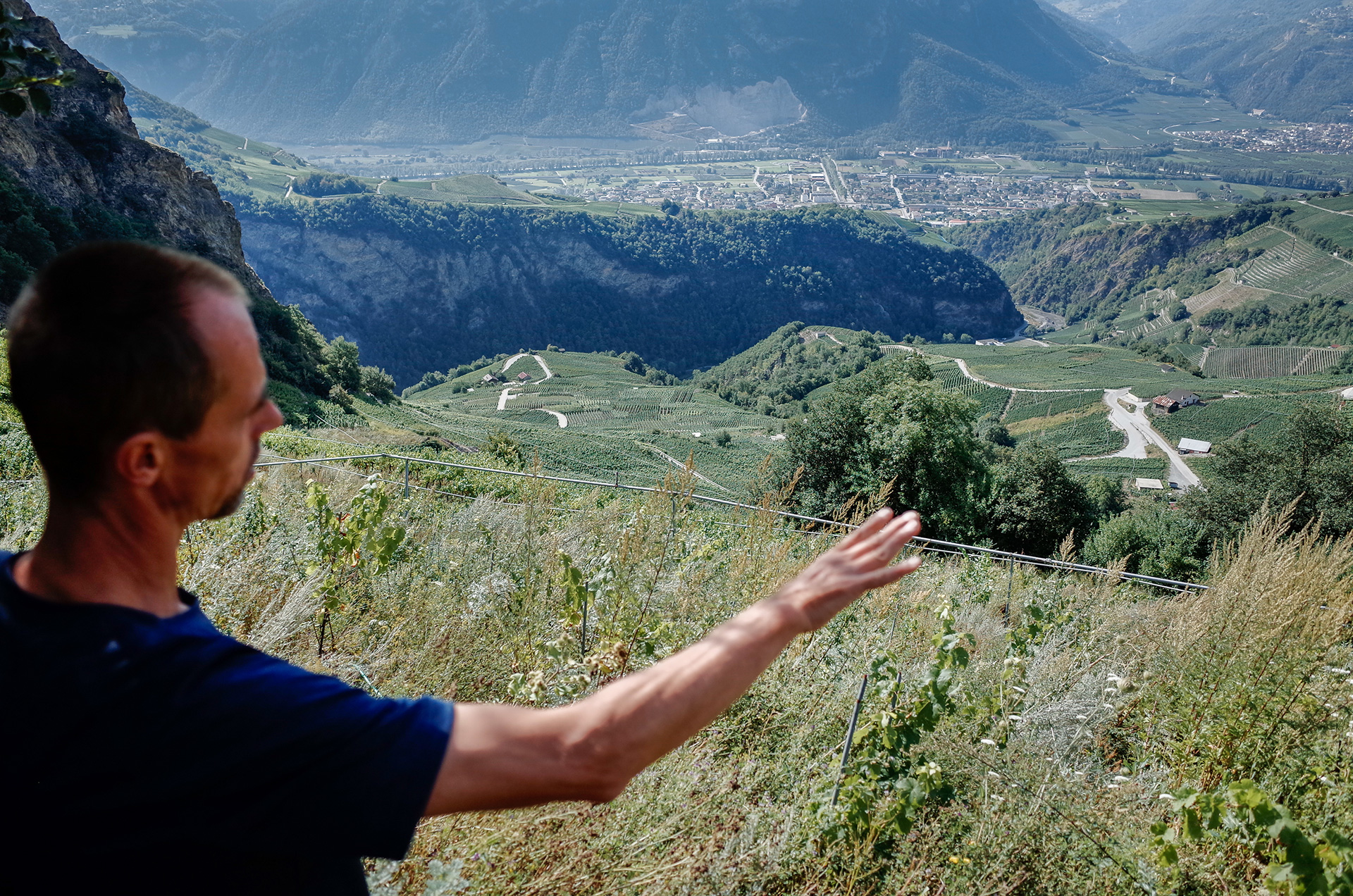
Effortlessly digging his hand into the earth like a shovel, he looked up and said, “We are at the steepest part and still all 40mm of water from that storm infiltrated the soil and was retained. At Mythopia, we always have evaporation to extract heat and the soil always keeps moist enough. Everyone says the harvest in Valais will be two to four weeks early this year from the excessive heat.” Schmidt turned to me with a grin and said “for us, it will be the same harvest as any year.”
—————
Schmidt founded the Ithaka Institute for Carbon Intelligence in 2007 while he was working as the managing and research director for Delinat, a company that markets, certifies, and exports industrial-scale organic wines. After five years, Schmidt decided to split the institute away from Delinat in an independent direction to focus more on projects relating to climate farming and food security, and to apply field-trial research made at Mythopia to new crops in new continents.
The primary impetus of the diverse research program at the Ithaka Institute is the use of biomass charcoal, or biochar.
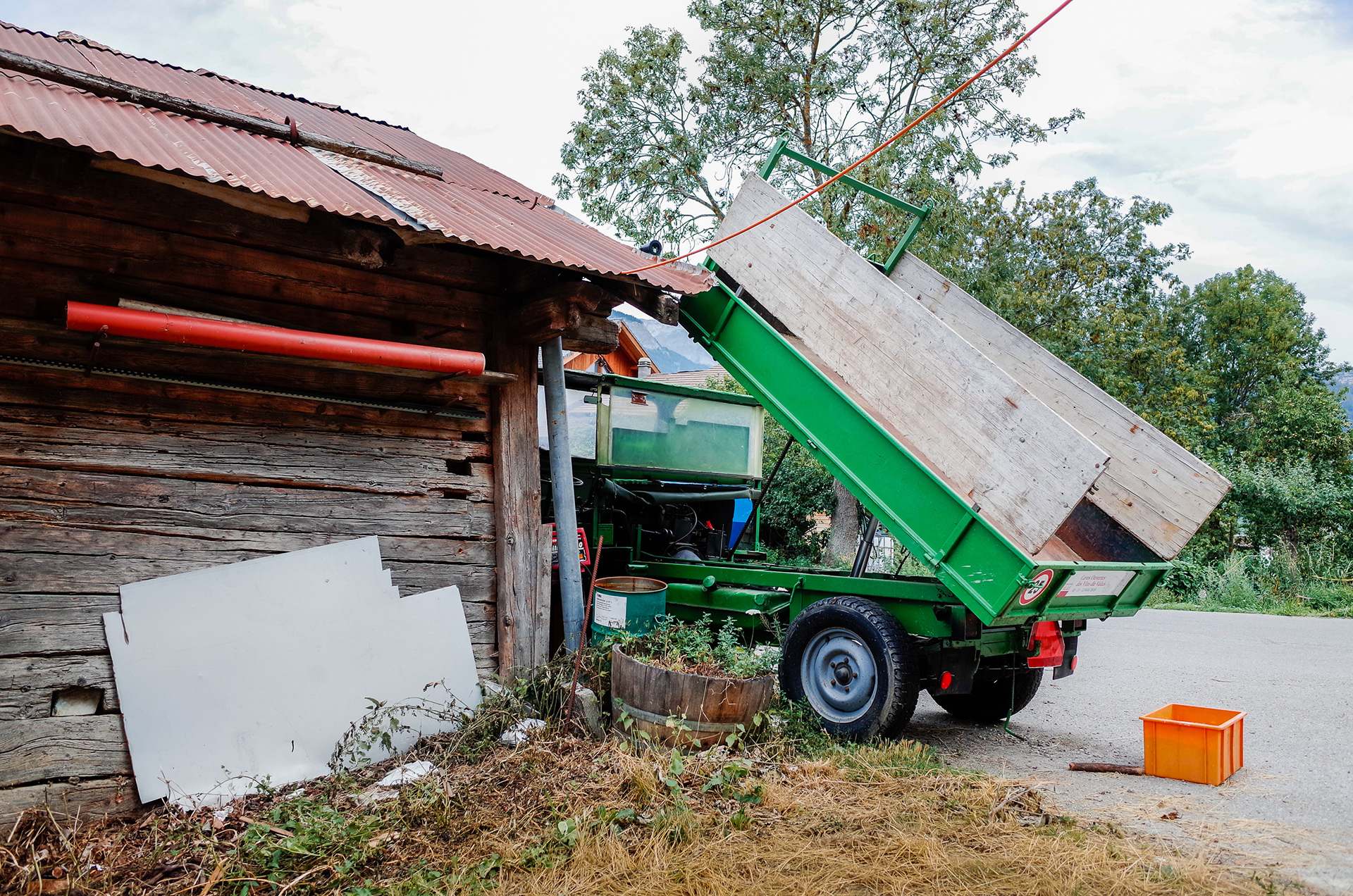
To put it simply, biochar is a type of charcoal that is made by heating organic materials at high temperatures in an inert atmosphere, or pyrolysis. Although it’s derived mostly from agricultural plant waste, biochar can be used in 55 different ways expanding beyond the scope of the farm. It’s predominantly used today as a soil conditioner and in raising animals, but can also be converted into building materials, textiles or water filtration systems, all of which can be attributed to foundational research done by Schmidt and his team at the Ithaka Institute. In fact, Schmidt was the first to establish a biochar field trial in Europe and spearheaded its application in viticulture with Mythopia.
Biochar substrates were found not to be effective when applied directly to grapevines at Mythopia, but the plethora of fruit trees and vegetable gardens that are contributing to the vineyard’s exhilarating biodiversity are however thriving with biochar in their soils.
Inspired by traditional soil amendment practices of Pre-Columbian Amazonian civilizations that contributed to their nutrient rich Terra Preta, it’s astonishing that the use of biochar is even more relevant in today’s climate considering it can absorb and retain carbon dioxide from the atmosphere. Don’t just take it granted from the hype; activated charcoal isn’t just a health food trend that can cure your hangover and brighten your teeth, its carbon negative impact could actually combat climate change.
In Nepal, Schmidt founded a branch of Ithaka Institute while conducting 150 field trials all over the Eastern half of the country set up with regional crops in 15 different villages. As a consultant, he works with local communities to revitalize their farmlands and grow higher value crops. A major component of these projects is converting fallow fields into forest gardens of fruit trees and regional cash crops.
The Ithaka Institute is also behind a very fascinating coffee growing and biochar initiative that has huge potential based on evidence of examples from nine coffee-growing regions. Schmidt’s first trials with coffee are taking place in Nepal because the institute already has a system in place, but he is focusing a lot of effort to a government-funded organic fertilization project in Cuba that also includes working with coffee producers.
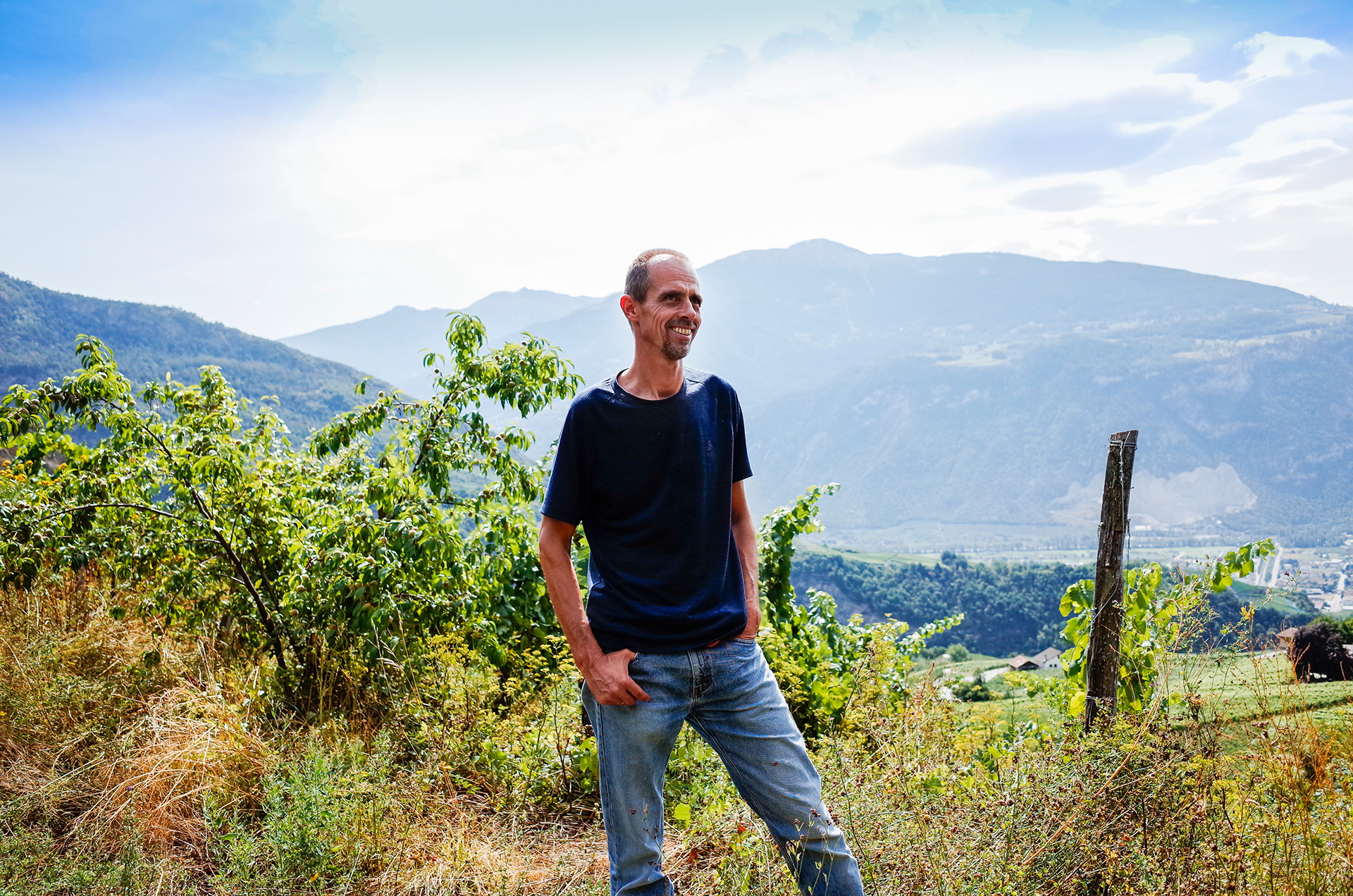
Unlike the grape vines at Mythopia, coffee shrubs benefit directly from biochar substrates and most effectively in tropical or subtropical climates, making Cuba an opportunistic location. Although there are heaps of bureaucratic hurdles in both Nepal and Cuba, Schmidt is determined to produce high-quality coffee and partner with post coffee production specialists to be able to offer green coffee samples to coffee roasters by 2020. This should come as good news to anyone that drinks coffee and loves wines like those of Mythopia (so Sprudge readers, basically).
Schmidt explained that his projects are often in regions that cannot manage the costs of planting and tending to something as complex as a forest garden. To alleviate those costs, he introduces the farmers to CO2 credit programs that allow eco-conscious European clients to offset their carbon footprint through subscription payments. Through this program, Ithaka has collectively planted over 50,000 trees in Nepal in just three years and is not stopping there.
Within this CO2 program, Schmidt worked with his team to develop a smartphone application that allows the end clients to have complete transparency into where their contributions are going down to the exact farmer and tree. Therefore the client can buy products like coffee beans and follow the whole process line from the production and drying to packaging and transporting. “This will enable direct producer-consumer relations where a coffee drinker in Europe will know exactly where and how his coffee was produced,” Schmidt said. “Thus you will get Grand Cru coffee like wine through the direct valorization of the artisanal production art.”
Right around the moment that Schmidt started to tell me about the first harvest of his new winemaking project in Andalusia, I had to wonder if the vines at Mythopia were in reality, entirely self-sufficient.
“Let’s take the shortcut,” Schmidt said as he confidently leads downslope through the patches of tall grasses, legumes, and thorns in a center trail through a vineyard of Pinot Noir.
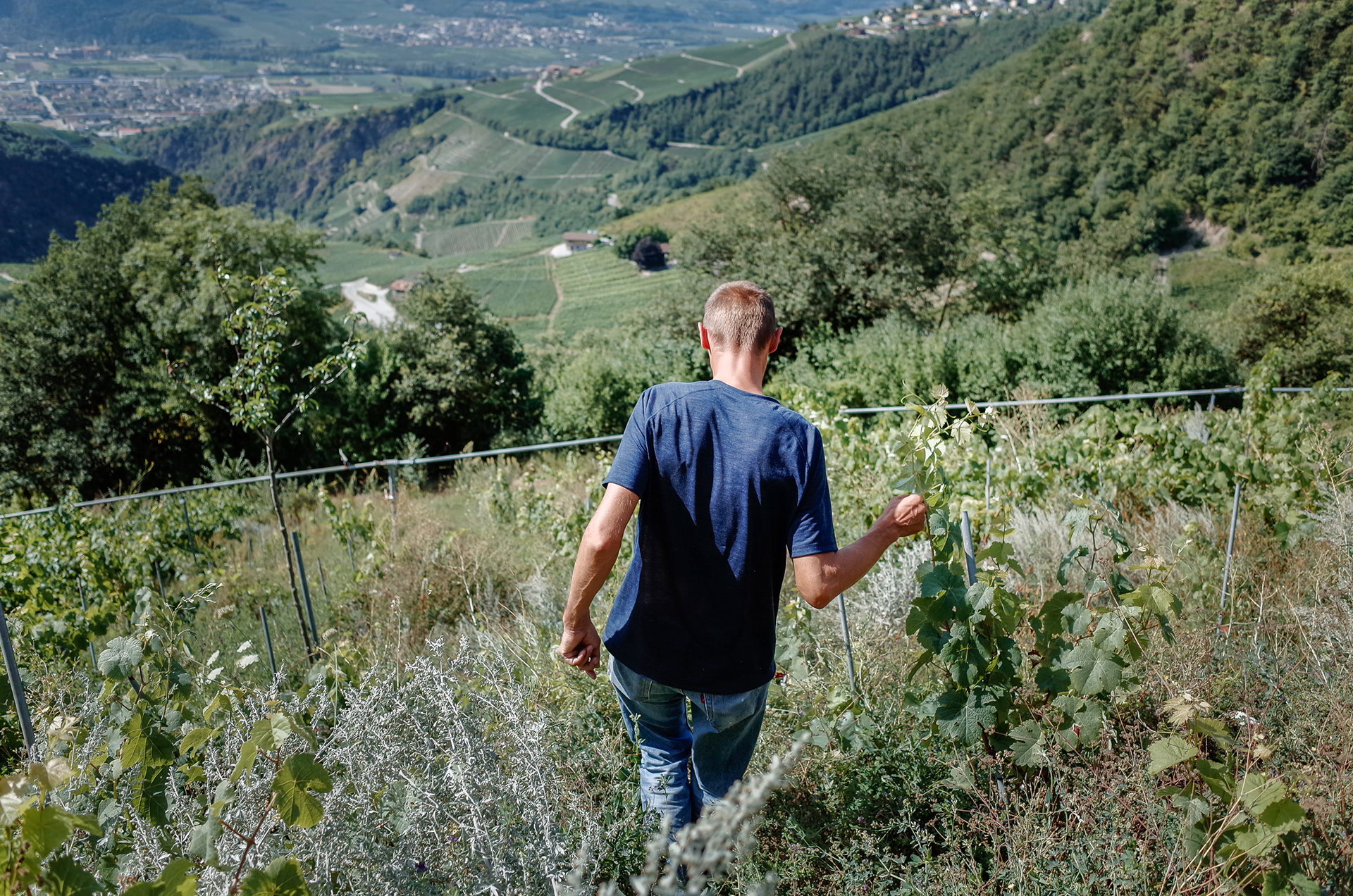
—————
“This top vineyard looks wild now, but it’s all to instill nitrogen to the soil and also serves as water and nutrient congruence,” he said while pushing through the vegetation. “We don’t work much here, we just let it grow.” To prevent the grapes from taking too much water, Schmidt fertilizes the soil with green manure that creates a carpet of hardy greens and grains. “When it rains for days on end, the green manure infiltrates the water and captures it, and balances the water content.”
As we stumbled from the upper vineyard to the border of a neighboring farm, a row of swollen Pinot Noir grapes coated in bird nets on naked soils came as no surprise, but was a dead giveaway as to where the Mythopia property line ended. That morning, I had walked from the town of Sion to meet Schmidt in Arbaz through 10 kilometers of magnificent views of the rolling vineyards of the Valais AOC, but I’d seen nothing but grapes presumably ready to burst out of their skin, often crowded by elbow-to-elbow welded pipes assembled as irrigation sprinkler systems, and often coated in a sprayed silverish powder.
Due to the chances of draughts in the Valais, it’s necessary at desperate times to use water control during the summer, but to Schmidt it’s all about a balanced approach. A few times each year, he will add water in some of the steeper vineyards at Mythopia, but it’s through a subterranean drip irrigation system that mitigates runoff, water waste, surface evaporation, and vine disease. “We consider our use of water as small-scale quality management, whereas these sprinkler systems,” he pointed towards the neighboring vineyards, “these are evidently used to manage quantity.” To Schmidt, this is not wine growing, but he certainly reconciles with the certain economic sense.
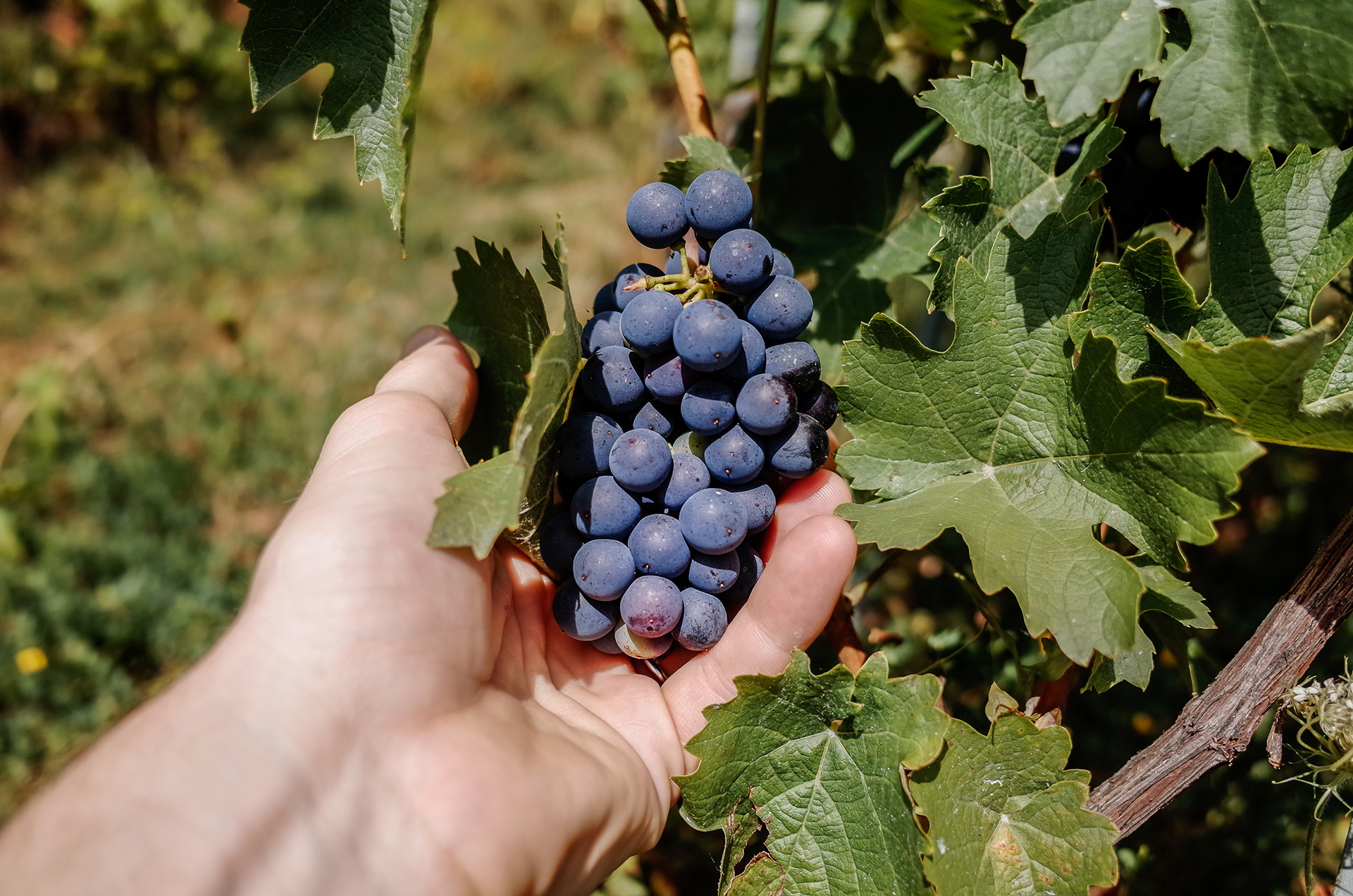
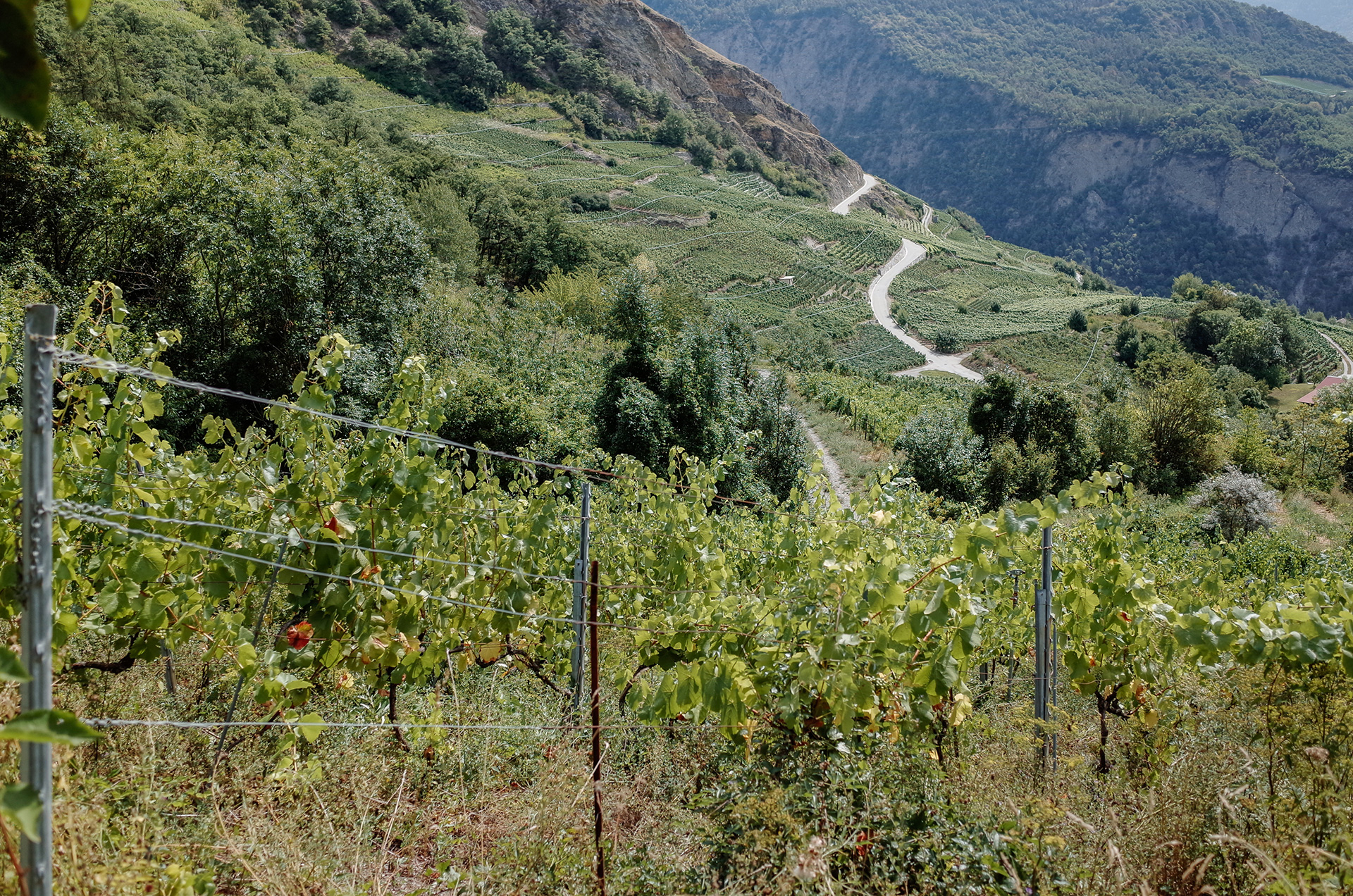
“It’s not really profitable, like all agriculture in high-income countries that has survive off of government subsidies for the sake of cultural preservation,” Schmidt said as we continued along towards the western tree line of the valley. “The Swiss want to preserve a cultural heritage farmer nation aspect, but on the other side they are requiring things to be done a certain way to keep it economic,” he explained. “This doesn’t align with the Swiss Watch approach.”
Alluding to the fact that nearly 98% of Swiss wine doesn’t leave the border, he continued, “If this unique geographical location was mostly natural winemakers, we could be a world market leader, and all selling our wines in other countries for 60 euros a bottle.”
—————
We had arrived at the tip of Schmidt’s property, and right away he started to pick fruit out of trees and passed me an apple. “When you visit our vineyard March through November, you should always find plenty to eat,” he said with a grin.
While I was picking hundreds of burrs from my sneakers, he picked some Reines Claude Plums from a tree and went in the woods and started to pull a grey tarp off a huge metal bucket filled with a cloudy liquid. “It’s just water and fermented grape leaves. It’s like a watery Sauerkraut, but it’s sweet,” he said while handing me one of the plums. I was hesitant to taste it at first, but the small slurp of the liquid from the palm of my free hand reminded me of a homemade kombucha. Schmidt adds this liquid with a local raw milk and manually sprays it as foliar fertilizer for the vines. He pointed out, “If a fertilizer smells bad to us, why should it smell good to animals or other forms of life in the soil?”
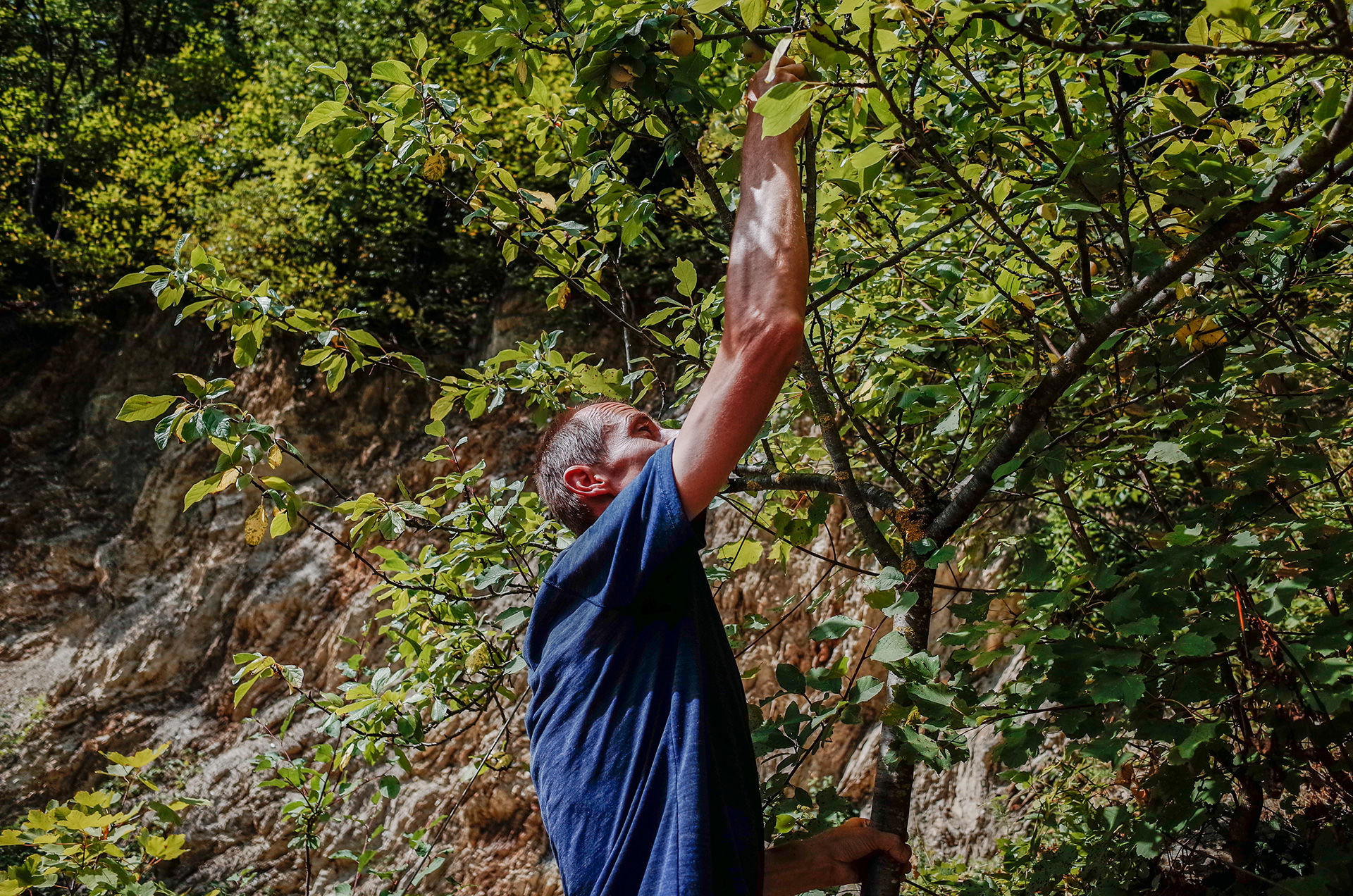
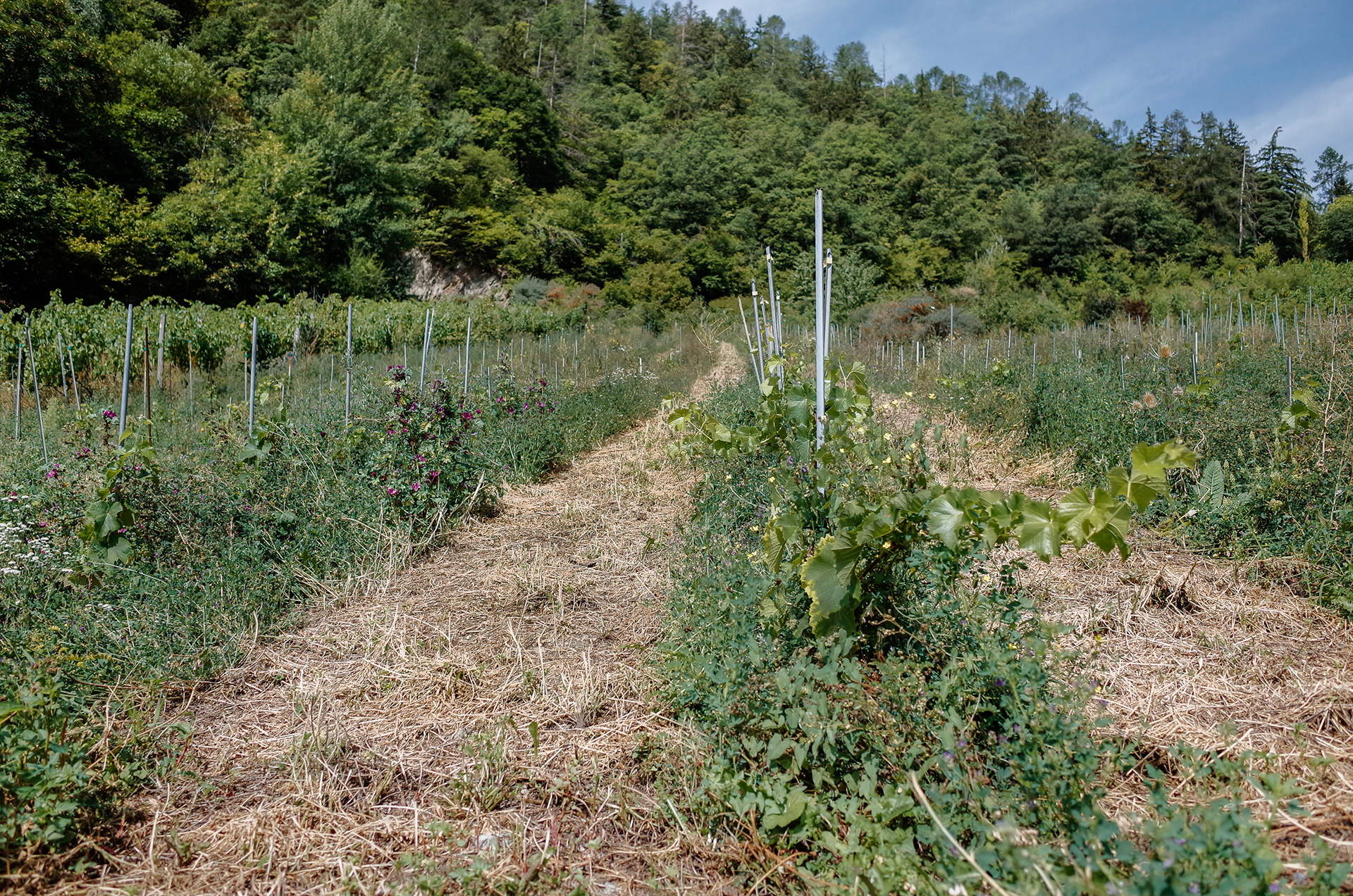
Bordering the forest line, there are several vineyards with vines that are at least one to two years away from production potential. Schmidt explained that they all consist of different natural cultivars and are only named by numbers. These type of varieties in particular are known to be resistant to disease and don’t require fungicidal treatments. Although they don’t share the same classifiable noble identities as classic European grape varieties, Schmidt is convinced that he can make these grapes into delicious red wines with their own unique and valuable expression.
“There is still this old wine world that says that some grapes are predetermined to be red or white or that you have to grow a specific variety in a given terroir,” he told me. “In the end, it’s the wine that must be good. All of our wines are Mythopia, so if you trust our name you will trust in the bottle.”
—————
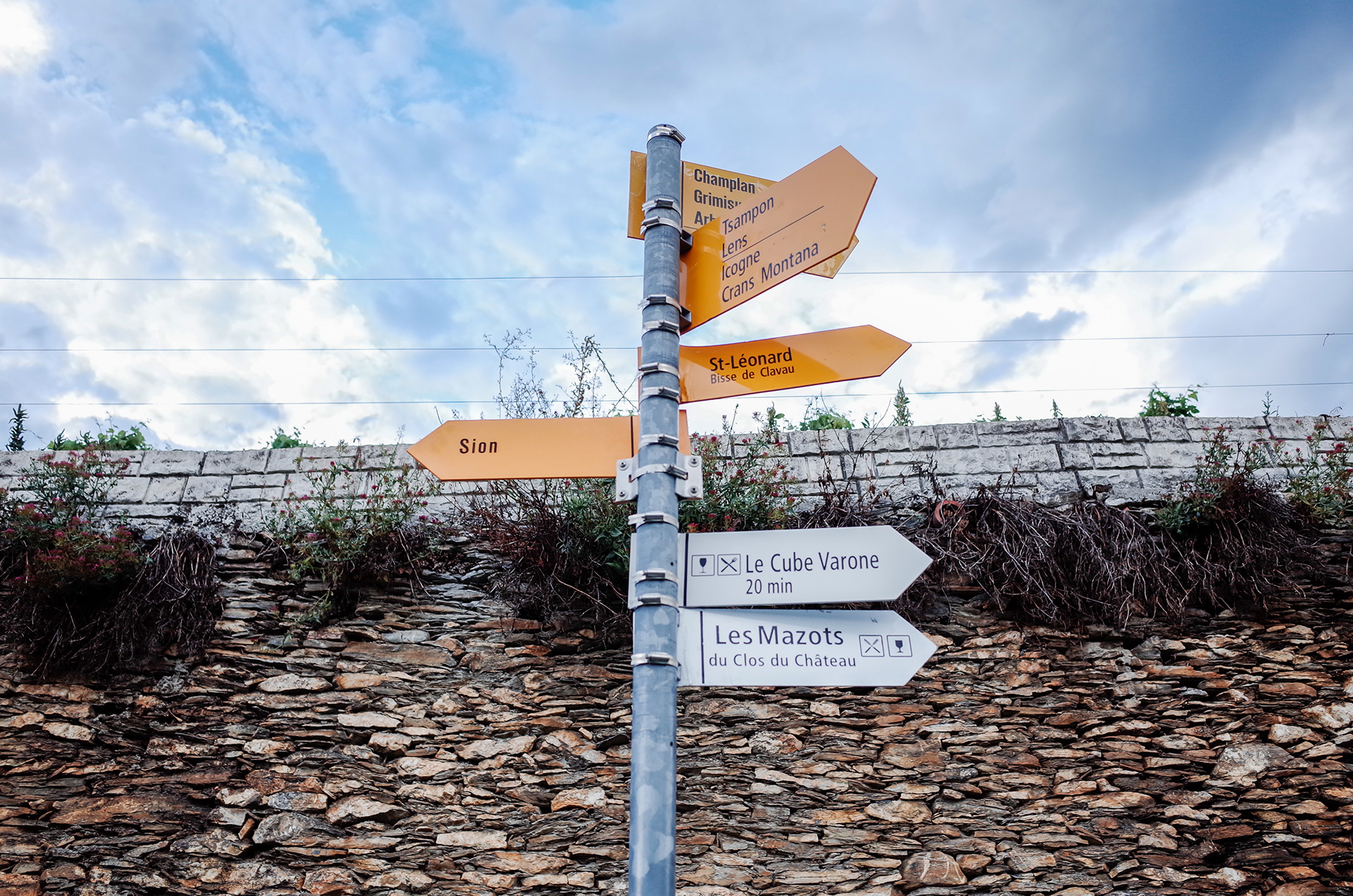
I was telling Schmidt on the way to his cellar that the previous evening, I stopped into a friendly bar and bottle shop in Sion called “Le Verre à Pied” that also coexists as a collaborative showroom for the Valais AOC. The manager and owner were both wildly astounded that they had never even heard of Mythopia, and thus doubted the global accolades that I had insisted were in existence.
“It wasn’t an important detail to me, so in 2013 I just stopped labelling our bottles with the AOC to focus on their identity as Heroic Alpine Wines.” For the same autonomous philosophy, he also decided to leave Mythopias organic certification off of the label unless requested by a specific restaurant or client.
Schmidt searched his cellar for a screwdriver, and ended up settling on using a screwdriver and pliers to uncork a bottle of 2013 “Disobedience” of Fendant (Valais specific name for the Chasselas grape). He filled one glass from the bottle and one from the tank while he started to go into detail on how the effect of oxidation is what keeps Mythopias wines stable. “Once the wine passes this stage, you could pour it in the glass, and drink it tomorrow.”
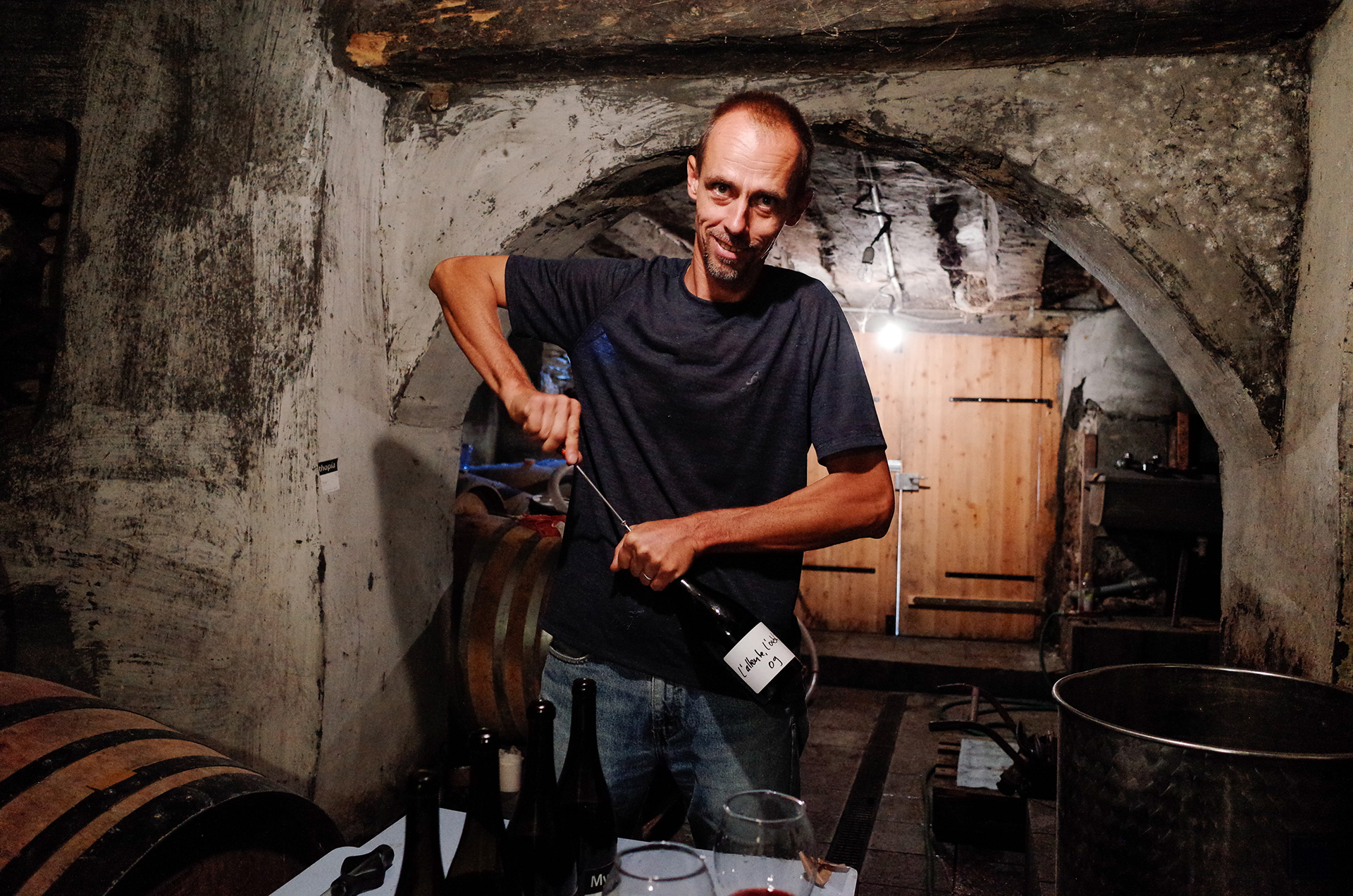
The next three wines in the lineup were all very different but all made with Pinot Noir; a 2014 “Insoumis,” a 2013 “Illusion” (labelled with AOC), and a 2014 “π-no” (pronounced as “Pi-No”). There was no doubt that all were delicious, but my personal preference aligned with Schmidts on the latter of the three.
“Pi-No is a wine that you could still remember distinctly even after drinking an entire bottle. You get lost in the tastes themselves and not so much in profiling them,” Schmidt said. “This wine is more like taking a bath and as you enjoy the warm water… there are different currents… they come and go… you discover something new,” he said pensively with his nose affixed above the glass.
There was one last bottle he had in store, and hand written on its white label was the name of a Maurice Blanchot novel, “L’attente L’oublis.” Without mentioning the grape or any details except that it is yet to be released, he poured out a glowing orange wine engulfed in aromas of sweet almonds and Madeira. It was so enigmatic that when he took a few bottles to Copenhagen, not even some of the top sommeliers in the world at his client’s restaurants could accurately pin it down. It was so pure and light, cognac-like, and volatile but delicate, yet it was a Pinot Noir from 2009. “There is no wine like this,” Schmidt said, for which I needed no convincing.
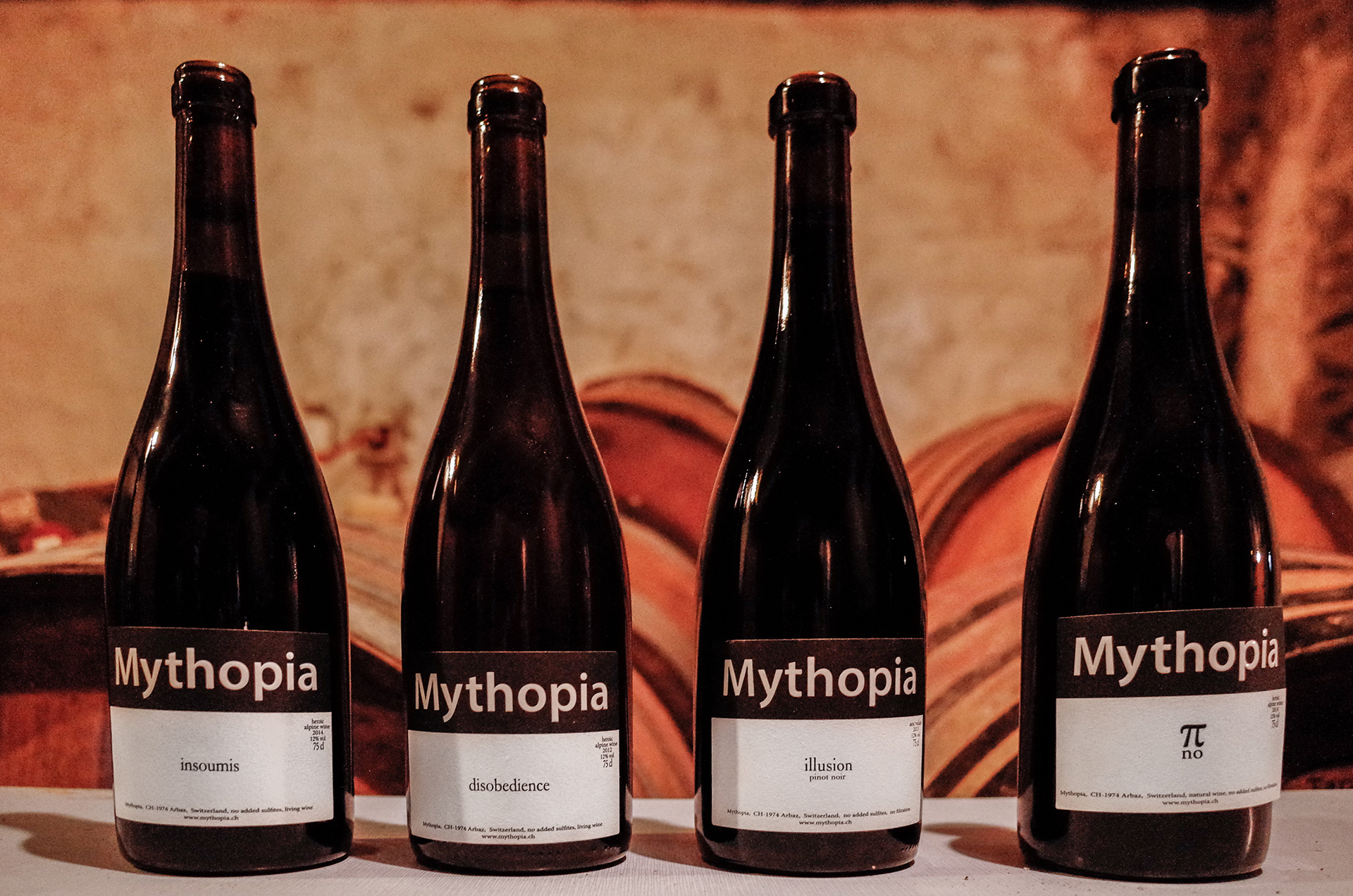
—————
Sprouting Mythopia from the ground up has been, if you will forgive this bit of editorializing, a wild, unmitigated success. Not only are these wines some of the most sought after “waitlist” natural wines in the world, but the vineyard itself has served as a sort of training grounds for projects around the world that help farmers better their lives and help combat global warming.
“I think back to why I started the vineyard in the first place… I needed to see the practices from all sides; the archaeology of experience,” Schmidt recalled. When he works with other farmers now, he can grab the shovel and show them. This has a huge impact in the effectivity and specificity of his consultation. “Anywhere in the world, we understand each other, walk the same speed and speak the same language,” he said. “The impact from the rigorous work and research done at Mythopia simply can’t be fit into a 750 ml bottle.”
Alexander Gable (@mrgable) is a freelance journalist based in Milan. Read more Alexander Gable for Sprudge Wine.












